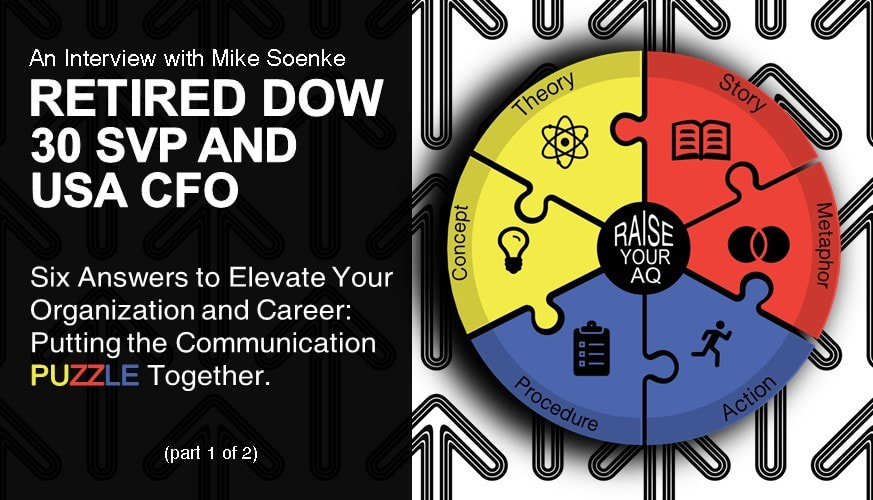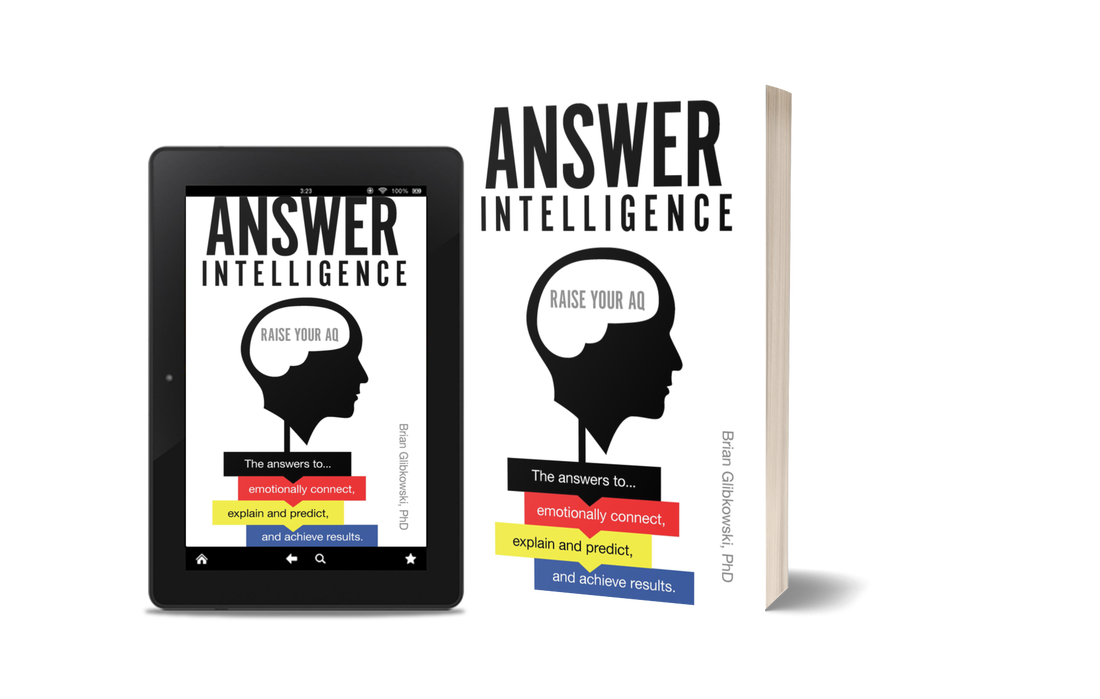|
Mike Soenke is an Executive in Residence at North Central College (Naperville, IL, USA) and retired DOW 30 SVP and USA CFO. In this two-part series, Mike and I discuss Answer Intelligence (AQ)® based upon his experience as a former executive at a DOW 30 corporation. The focus of this blog post (1 of 2) is using AQ to elevate an organization and the next post will be about using AQ to elevate your career. The following interview is edited for clarity. This article is part of the High AQ Interview Series where executives, academics, and thought leaders discuss elevated answers. RelevanceDr. G: “Is AQ important to senior leaders and the organization as a whole?” Mike Soenke: “In my career, as I and others elevated into leadership roles we were amazed at how much of our time was invested in communication. In a large system, there are many stakeholders - including employees, suppliers, vendors, and partners. All of the stakeholders need to understand the vision, strategy, goals, and their role in the implementation.” “In all of my years in the corporate world, I never saw anything in my career like AQ. There are many resources about questions and proactive communication, but not a lot on the most effective ways to connect and respond by providing answers.” Dr. G: “What value add does AQ have?” Mike Soenke: “There are a lot of tried-and-true communication principles that are captured in the framework. For example, telling a story that draws someone in. Also, at our organization, we had the coffers full of organically grown metaphors. Additionally, appealing to both sides of the brain when you communicate [High AQ Practice 2: Answer Twice] is familiar. The real value-add of the thought framework is that it brings it all together and helps people in a structured and logical way. The 5 High AQ practices help you put the framework to work and optimize its effectiveness to further enhance the value-add of the framework.” To punctuate his point, Mike provided an example of a senior leader that was formerly at two competitors. He arrived, got up to speed quickly and used his huge knowledge base. More importantly, he would make connections that others did not see (he was very strategic). When these connections were made, Mike said, “It clicked in your mind and you were immediately upset with yourself that you did not make the connection (it was so intuitive). You were mad at yourself that you had not thought about it prior. I put AQ in this category. Like pieces of a puzzle that fit together, as soon as you see them together, you say to yourself, of course this makes sense. Why has nobody thought of this before? That is the power and magic of AQ.” Dr. G: How would you describe taking advantage of the 5 High AQ practices to someone learning about AQ for the first time? Mike Soenke: “The framework is simple and sophisticated and layered. When you first learn AQ, I recommend focusing upon knowing the six answers and which questions they answer. I would estimate that 50% of the value is in High AQ Practice 1 (Provide Six Answers). Simply knowing there are six answers and cataloguing them to questions is a tremendous advantage.” “Then as you peel the onion back… answering twice, providing complementary answers, using the three styles, are examples of how you can move from novice to expert as you master the sophistication of all the layers. The layering is interesting. AQ provides simplicity at the foundational level [Practice 1] but offers deeper and sophisticated tools and skill as you work through the High AQ Practices 2 to 5. Now you are adding layers of brilliance to it.” High AQ Takeway 1: According to Mike Soenke, 50% of the value in AQ is in learning High AQ Practice 1 and 50% is in learning High AQ Practices 2 to 5. Persons new to AQ should focus on High AQ Practice 1 and experts need to master High AQ Practices 2 to 5. AdoptionDr. G: “How would an organization best adopt AQ? Mike Soenke: “In my experience a framework like AQ enters an organization through executive leadership. They would get value in it and get passionate about, and then want to adopt it organizational wide. This is how it worked for us when we adopted programs to improve the culture, teamwork and communication in the company. After initial training, lunch and learns and small group support tools were conducted to further embed the framework, its terms, and syntax into the culture. That is a significant investment and difficult to do if leadership is not bought in up front. In my mind it is so critical for the ultimate success of a significant program if it starts with senior leadership." Dr. G: “Interesting that with other frameworks a lot of time is spent on learning the syntax and terms. Do you think there is something that is more intuitive about AQ?” Mike Soenke: “I think AQ is potentially more intuitive, in that it is built upon questions (why, why, how, where, where) and answers (story, metaphor, theory, concept, procedure, action) that we are mostly familiar with in everyday communication. Plus, the idea of using a communication framework based on questions and answers is just very logical and straightforward. I think all of this in combination can lead to easier adoption.” High AQ Takeway 2: According to Mike Soenke, AQ is best adopted top-down from senior leadership and AQ has a higher-chance of successful adoption because the framework is simple and intuitive. Take a look at the Part 2 of this blog post series, AQ and your career.
If you found Answer Intelligence (AQ)® an interesting framework, please share this post with others.
0 Comments
Leave a Reply. |
Access Octomono Masonry Settings
AuthorDr. Brian Glibkowski is the author of Answer Intelligence: Raise your AQ. Archives
October 2022
Categories
All
|
About AQ
Answer Intelligence (AQ)™ is the ability to provide elevated answers to explain and predict in a complex world, emotionally connect, and achieve results. Are you conversation ready?
Meet HarperHarper's story illustrates the transformative power of AQ in her own career and in the success of her organization.
|
AQ Upskilling PlatformAI is machine thinking. AQ is human thinking (developed based on academic research) in terms of simple questions (why, what, how, when, where, who) and answers (concept, metaphor, theory, story, procedure, action) that elevate human-to-AI and human-to-human communication.
|
Quick Access LinksBuy the Book
Explore AQ (Free Assessment) AQ TEDx Video Professional Services Firms + AQ Brian Glibkowski, PhD - AQ Creator Meet Harper - Overview Video Meet Mark - Software Case Reasons You Need AQ |
Featured |




 RSS Feed
RSS Feed